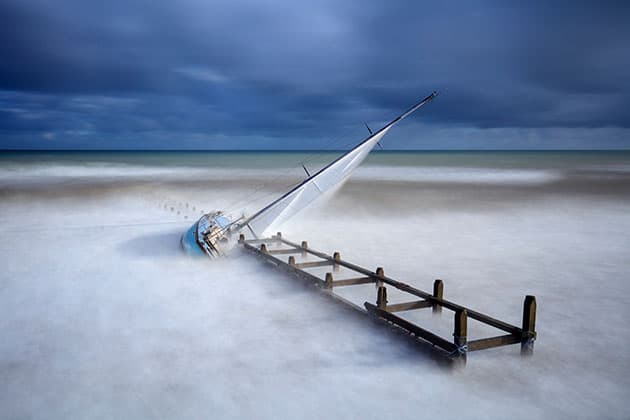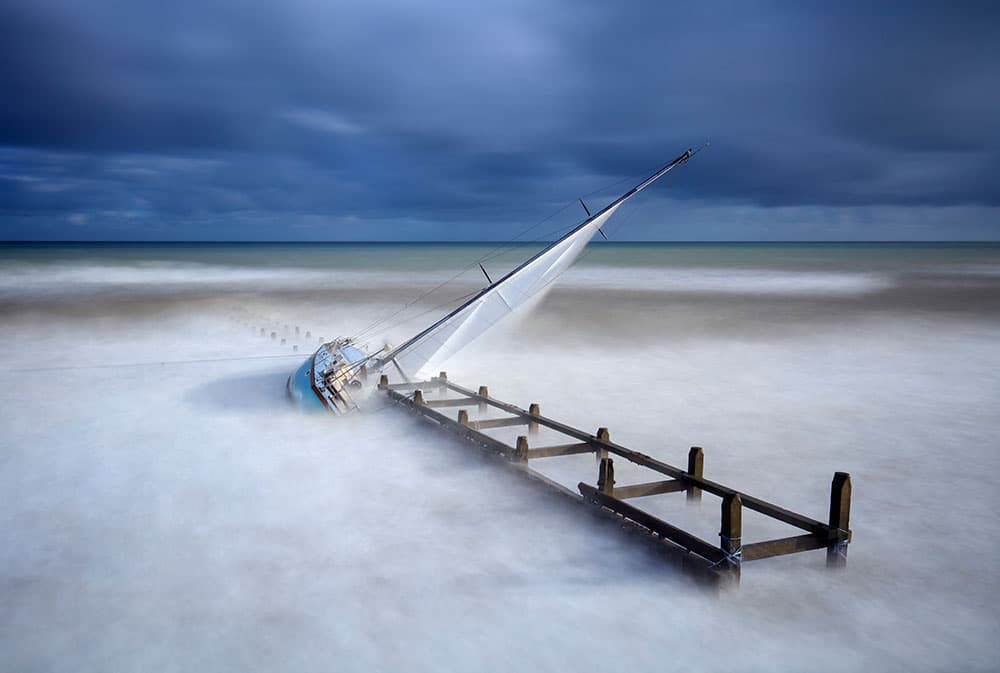
Canon EOS 5DS, 16-35mm, 30sec at f/14, ISO 100. Credit: Chris Herring
The Shipwrecked Mariners’ Society was founded in February 1839 as a result of the tragic loss of a fleet of fishing boats on the north Devon coast in October 1838. Since then the society has become one of the largest national maritime charities. Today, the society’s main purpose is to provide financial support to individuals and their dependents who are in need, and who have worked at sea in the Merchant Navy and fishing fleets. Each year the society organises a photo competition to showcase the UK’s coastline and its associated people and industry.
AP Editor Nigel Atherton was part of the judging panel and helped to whittle down nearly 1,000 entries to determine the winners of the four main categories – Ships and Wrecks, Industry, People and Recreation, Coastal Views – and of course the overall winner. Chris Herring, a professional photographer from Norfolk, scooped the prestigious title this year.
We speak to Chris and some of the other category winners and highly commended photographers about their images and what tips they can offer other photographers.
Fighting until the End, Cart Gap, Norfolk by Chris Herring
Winner, Ships and Wrecks
‘I stumbled upon this yacht by chance; it had run aground the previous day after the wind had dropped. There was a lovely mist along the coastline so I took a few photos. I decided to return a few days later and took this image. There was debris from the boat scattered all along the coastline and as the sea was rough and unpredictable I decided to shoot from the sea wall overlooking the yacht. I fitted a Lee Little Stopper to increase the exposure time and was fortunate the sun came out and looked great with the stormy sky.’ Visit www.theuklandscape.com.
Chris’s tips
- Keep visiting the same location and try to capture the same image in different lighting conditions and with different compositions. If shooting on the coast also visit during different tidal conditions.
- Always react to the light and weather conditions. Think about the lighting and sky carefully when setting up your shots and always be prepared to change your viewpoint if needed.
- Sand and salty water do not mix well with tripods. Always leave the bottom leg extended by around five inches so the locks and levers are not getting sand and salt in the important parts, and when you get home rinse with water.
- Check tide times carefully; it’s incredibly easy to get caught out with incoming tides. Local knowledge or getting to know where the tide can cut you off on some beaches is extremely important.
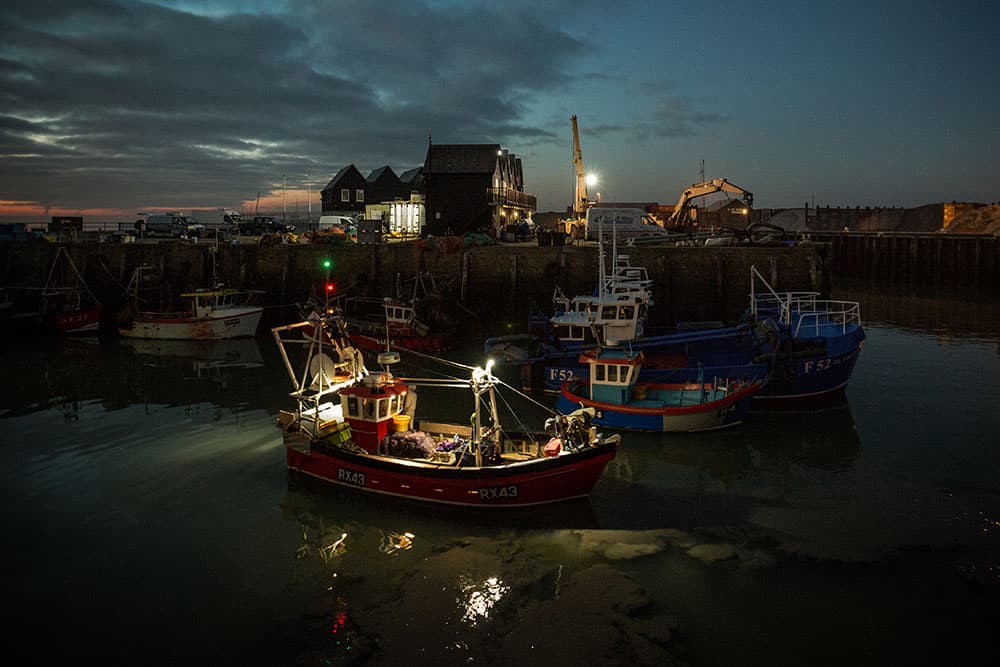
Canon EOS 5D Mark III, 16-35mm, 1/25sec at f/4, ISO 5000. Credit: Michael Marsh
Full on Reverse, Whitstable by Michael Marsh
Highly Commended, Industry category
‘My image is one of a sequence of 11 shots of a local trawler returning with its catch to Whitstable harbour. The trawler entered and then reversed back into its mooring, aggressively churning up the mud as it went; hence [the photo’s] title “Full on Reverse”.’ Visit www.michaelmarsh-photography.co.uk.
Michael’s tips
- Always shoot in manual for full control over your camera settings and be prepared to constantly tweak settings in changing light conditions. I also recommend shooting raw image files for added control over the final outcome in post-production. This is particularly handy if your exposure isn’t quite spot on; it’s much easier to correct when working with raw files.
- You don’t have to travel far and wide to capture a variety of images. I live 500 yards from Whitstable harbour and can often be seen dashing down the beach at all times of the year with my camera. It doesn’t matter how often you visit the same location, there’s always something different to photograph as the coast is forever changing.
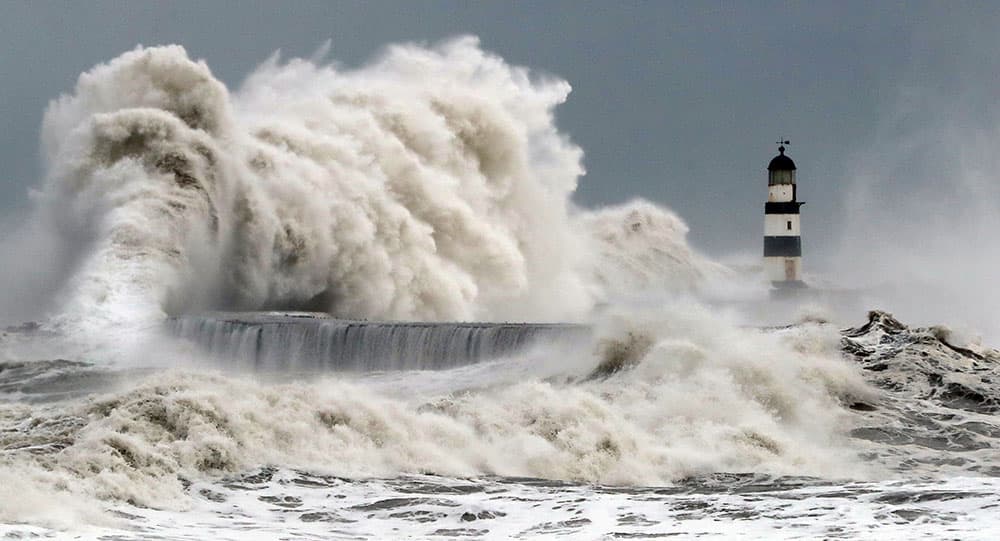
Canon EOS-1D X Mark II, 70-200mm +1.4x III, 1/1600sec at f/6.3, ISO 1600. Credit: Owen Humphreys
Stormy Seas, Seaham Harbour, Co. Durham by Owen Humphreys
Winner, Coastal Views category
‘I knew we had some strong North Easterly winds and a big tide so I went down to the coast. I tend to arrive a couple hours before high tide as I find that when you have a harbour wall where waves are crashing against them, arriving just before high tide works better. On this day the sea was particularly rough and it allowed me to get a good variety of pictures, but this image stood out to me. It shows the anger and power of the sea – something never to be underestimated.’ @owenhumphreys1
Owen’s tips
- The most important tip for taking pictures of the sea when in a storm is to stay safe. Please do not be tempted to get too close – no picture is worth losing your life for. The emergency services don’t want to be checking the coast for photographers.
- Try and keep your cameras covered in between taking photos, or better still, invest in some body and lens sleeves or covers to protect them from the elements. The combination of wind and waves will produce a lot of spray from the sea, which cameras don’t take kindly to.
- To keep a safe distance, use a long telephoto lens to get close to the action. Zooms are more versatile than primes.

Canon 5D Mark IV, 24-105mm, 1/30sec at f/4.5, ISO 6400. Credit: John Roberts
Dawn Fishing, Bay of Biscay by John Roberts
Winner, Industry category
‘I am a full-time commercial fisherman and this is a partner boat to one I work on. During the summer we work together trawling for tuna. On the morning after a night’s fishing, the other boat was hauling the nets out of the water. I managed to take a couple of photos just as the sun began to rise.’ @irishfishingphotos
John’s tips
- When shooting on a boat, your position and stability are very important. Lean or wedge yourself firmly against something and keep away from the side of the boat to avoid getting yourself and your equipment wet.
- When photographing a working crew, you need to stand back far enough to avoid getting in their way, so a versatile zoom telephoto lens is vital.
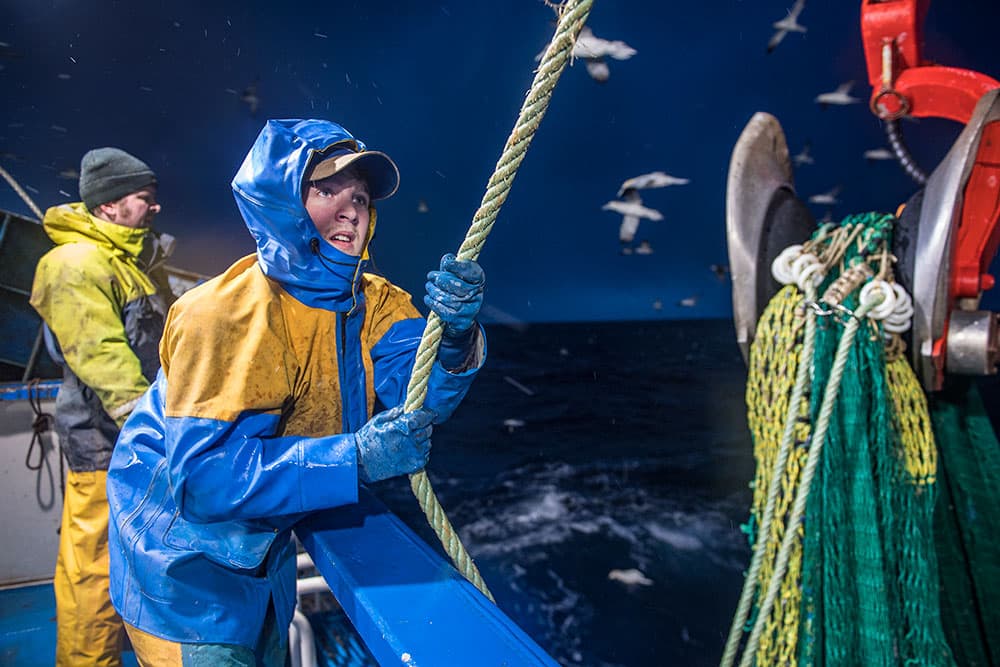
Nikon D5, 24-70mm, 1/250sec at f/2.8, ISO 1600. Credit: Gareth Easton
Lee onboard Guardian Angell LK 272, Shetland by Gareth Easton
Winner, People category
‘This image was taken on board a commercial fishing trawler in February earlier this year. It is one of the world’s most dangerous working environments, and a harsh unforgiving location for a photographer. Combating camera and subject movement was the main challenge I faced as the boat was constantly moving.’ Visit www.garetheastonphotography.com.
Gareth’s tips
- The crew move quickly around the deck so don’t expect them to stop while you compose your image. Choosing the correct shutter speed and focus mode is pivotal to your success – use a shutter speed that will freeze movement and the camera’s continuous autofocus mode to track your moving subjects.
- Always consider your personal safety. A harness-style jacket that only in ates if you fall overboard will allow you to work uninhibited. Communication with the crew at all times is key so you are familiar with the processes on board in order to remain safe.

Canon EOS 5D Mark IV, 24-70mm, 1/200sec at f/8, ISO 1000. Credit: Teri Pengilley
Dover, 5am, Dover by Teri Pengilley
Highly commended, people category
‘Lucy Sims is one of the Sea Gals: six girls aged 13/14, who swam across the English Channel as a relay team in a time of 13 hours and 23 minutes on 19 July 2018. Lucy, seen here, is swimming the first leg of the relay, having just left Samphire Hoe beach in Dover. Lucy was incredibly brave to get into the English Channel at first light and start swimming. As a storyteller, I like my images to have narrative. Here, the receding white cliffs of Dover, rising sun, and the power and determination of the young swimmer all help to tell the story.’ @teripengilley
Teri’s tips
- Understanding the light and the best times of day to shoot will make a big difference to your images. I knew from experience that this starting leg would make the best images, with the blue of the dawn light reflecting the coldness of the water. The softness of the early morning light reveals the details on the water’s surface.
- I’m a keen outdoors swimmer and I believe in photographing subjects who you are passionate about it, as it comes across in your photos. I was in absolute awe at these amazing young girls, so tiny in the vast expanse of water, yet powering through it. I still get goose bumps when I think about what they achieved that day.
- As well as capturing a technically great image, it’s important to think about your narrative. Choose a lens to capture your subject and their surroundings to add a sense of scale and tell a story. I shot wide with a 28mm lens to capture the scale of the Channel, with Lucy close enough for us to see her in relationship to her environment. Shooting close to the water helps to immerse the viewer into Lucy’s watery world.
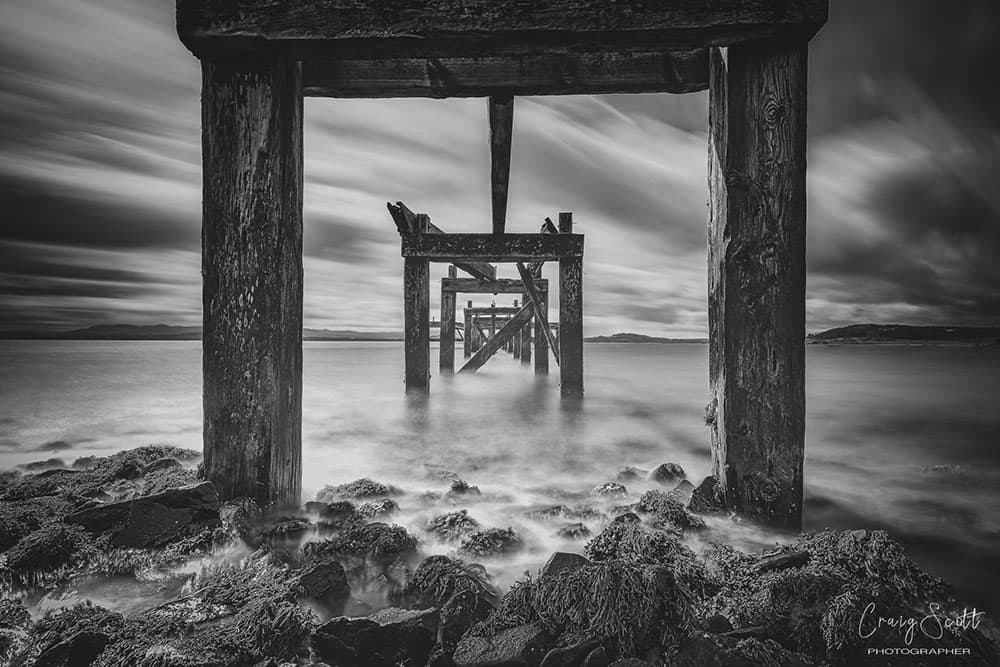
Nikon D750, 16-35mm, 121sec at f/9, ISO 50. Credit: Craig Scott
Just a Shell, Aberdour by Craig Scott
Highly commended, ships and Wrecks category
‘I had planned for this shot of the old pier at Aberdour for a while and the conditions had to be perfect. I had visited the pier several times to get an idea of the tide height at different times. I worked out that just before or after high tide would be best, so it was just a case of waiting for a cloudy and windy day.’ @craigscottphotographer
Craig’s tips
- Location research is vital, especially understanding the local tides.I regularly use www.tidetimes.co.uk to check tide heights too. There are certain locations where you can get caught out and the tide creeps around behind you, so put your safety first. I also look at other photographers’ work online to ensure I can try and create something a bit different.
- Always go fully prepared for all weather conditions and wear appropriate footwear. Take plenty of cleaning cloths and solution to keep lens and filters as clean as possible. I always have a face cloth wrapped around my lens and camera held on by one of my daughter’s hair bands, just in case I get caught out with an unexpected big wave.
Further reading
Tideschart

